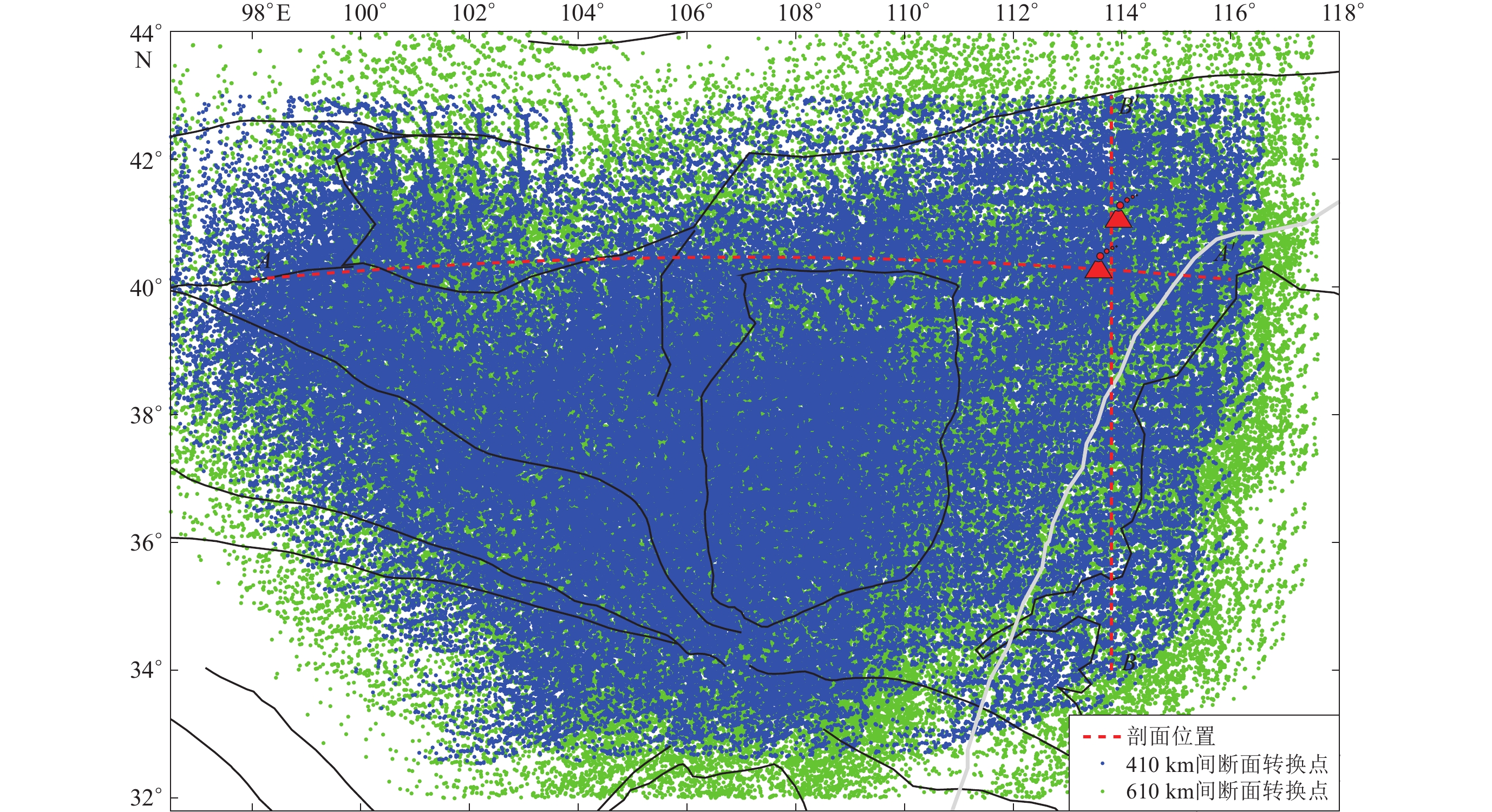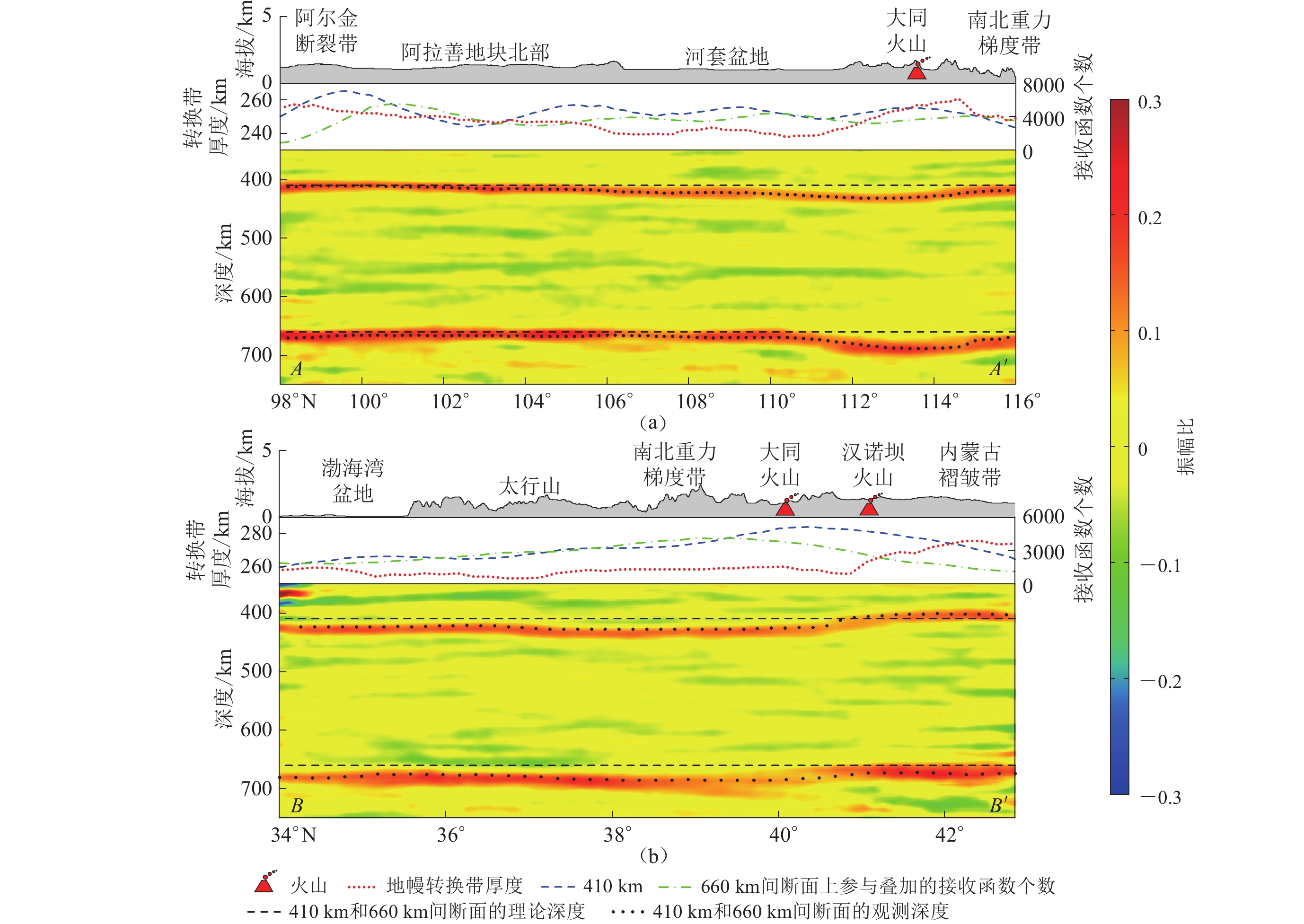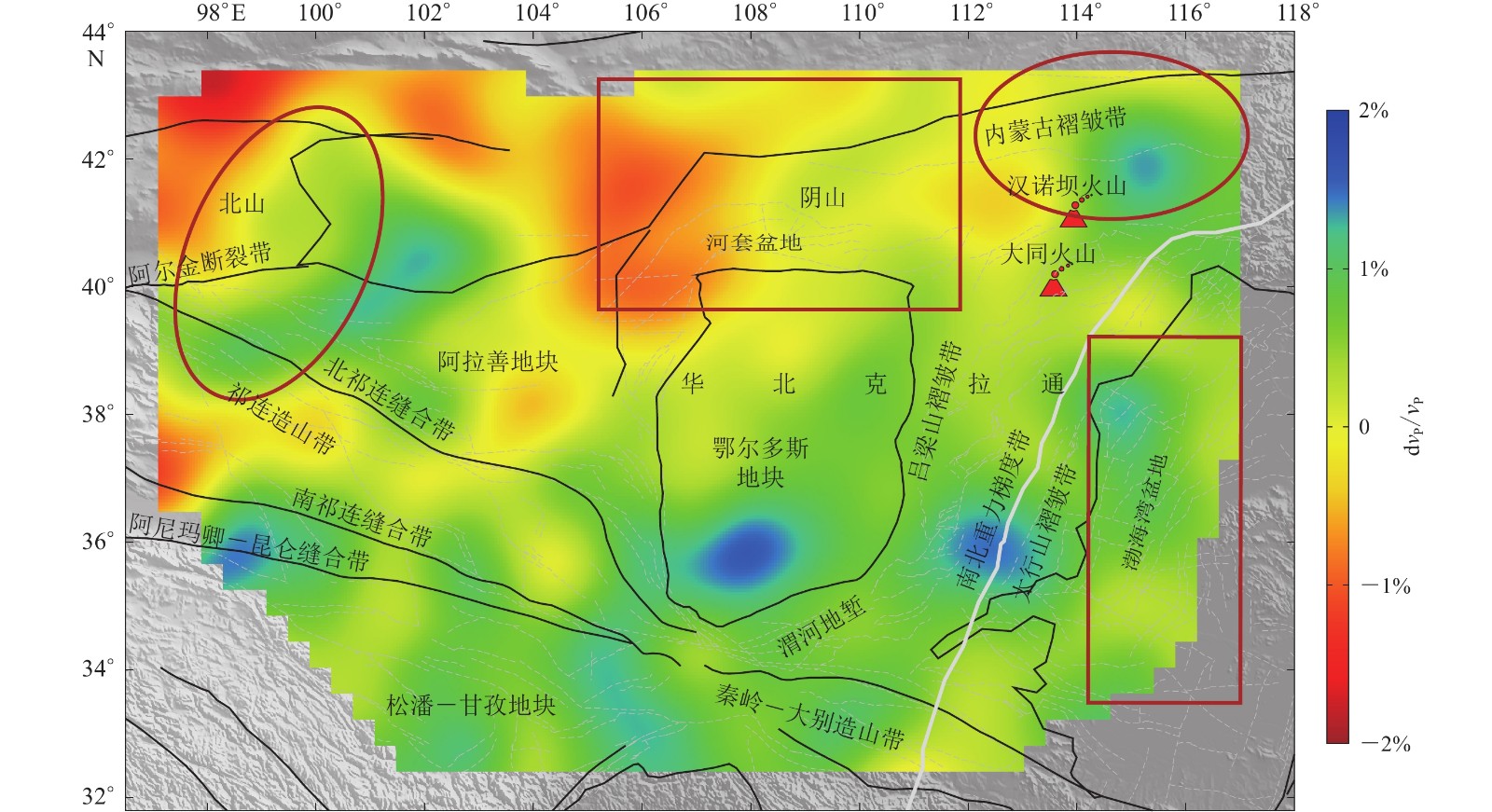Structure of the mantle transition zone beneath the central and western North China Craton and its adjacent areas revealed by P wave receiver functions
-
摘要: 通过处理ChinArray计划二期和三期台阵中823个台站的远震波形数据,共获得174 562个高质量的P波接收函数,采用接收函数共转换点(CCP)叠加方法开展华北克拉通中西部及其邻区的地幔转换带结构研究,获得了研究区地幔转换带的厚度分布。结果表明:研究区内地幔转换带厚度变化幅值在235—280 km范围内,具有分区特征;阿尔金断裂带东部和汉诺坝火山以北厚的转换带异常可能与冷的岩石圈拆沉有关;河套盆地和阴山造山带附近分布着相对薄的地幔转换带,这可能暗示了该地区存在热的地幔物质上涌或岩浆活动;渤海湾盆地下方厚的地幔转换带异常可能是冷的太平洋板片西向俯冲并滞留于地幔转换带所致。Abstract: We obtained a total of 174 562 high quality P wave receiver functions by processing the teleseismic waveform data recorded by 823 temporary seismic stations of ChinArray phase Ⅱ and Ⅲ deployments, and then used the receiver function common conversion point (CCP)stacking method to study the structure of the mantle transition zone beneath the central and western North China Craton and its adjacent areas. The estimated thickness of the mantle transition zone in this studied area varies from 235 km to 280 km and shows partitioned characteristics. The thick mantle transition zones beneath the eastern Altyn Tagh fault belt and the northern Hannuoba volcano may be related to the detachment of the cold lithosphere. The mantle transition zones beneath the Hetao basin and the Yinshan orogenic belt are thinner than the average of the global mantle transition zone, which maybe imply the upwelling of the hot mantle materials or magma activities. The anomaly of the thicker mantle transition zone beneath the Bohai Bay basin may be caused by the westward subduction of the cold Pacific plate and its remaining in the mantle transition zone.
-
-
图 1 研究区地震观测台站位置与区域构造背景
TA Ⅱ和TA Ⅲ分别表示中国地震局地球物理研究所组织实施的第二期和第三期流动观测台阵;61061为位于鄂尔多斯地块内的台站
Figure 1. Locations of the seismic stations and regional tectonic settings in the studied area
TA Ⅱ and TA Ⅲ represent the temporary seismic stations of ChinArray phase II and III deployments respectively organized by Institute of Geophysics,China Earthquake Administration. 61061 is the station located in Ordos block
图 3 61061台站按震中距排列的接收函数
每条接收函数为震中距5°范围内所有接收函数的叠加结果,四条红色虚线分别表示转换震相Pms,PpPs,P410s和P660s的理论走时
Figure 3. Receiver functions plotted as a function of the epicentral distance at station 61061
Each receiver function indicates the stacking of receiver functions binned every 5° in epicentral distance. Four red dashed lines represent the theoretical arrival times of Pms,PpPs,P410s and P660s phases
图 7 520 km深度的P波速度结构 (引自Tao et al,2018)
Figure 7. P wave velocity structure at 520 km depth (after Tao et al,2018)
-
白一鸣,艾印双,姜明明,何玉梅,陈棋福. 2018. 利用P波接收函数研究青藏高原东南缘地幔转换带结构[J]. 地球物理学报,61(2):570–583. doi: 10.6038/cjg2018L0182 Bai Y M,Ai Y S,Jiang M M,He Y M,Chen Q F. 2018. Structure of the mantle transition zone beneath the southeastern Tibetan Plateau revealed by P-wave receiver functions[J]. Chinese Journal of Geophysics,61(2):570–583 (in Chinese).
高翔,郭飚,陈九辉,刘启元,李顺成,李昱. 2018. 地幔上涌对鄂尔多斯西缘岩石圈的改造:来自远震多尺度层析成像的证据[J]. 地球物理学报,61(7):2736–2749. doi: 10.6038/cjg2018L0319 Gao X,Guo B,Chen J H,Liu Q Y,Li S C,Li Y. 2018. Rebuilding of the lithosphere beneath the western margin of Ordos:Evidence from multiscale seismic tomography[J]. Chinese Journal of Geophysics,61(7):2736–2749 (in Chinese).
郭慧丽,丁志峰,徐小明. 2017. 南北地震带北段的远震P波层析成像研究[J]. 地球物理学报,60(1):86–97. Guo H L,Ding Z F,Xu X M. 2017. Upper mantle structure beneath the northern South-North Seismic Zone from teleseismic traveltime data[J]. Chinese Journal of Geophysics,60(1):86–97 (in Chinese).
王炳瑜,陈凌,艾印双,何玉梅. 2013. 华北克拉通东北部及邻区地壳和地幔转换带厚度研究[J]. 地球物理学报,56(1):60–68. doi: 10.6038/cjg20130107 Wang B Y,Chen L,Ai Y S,He Y M. 2013. Crustal structure and mantle transition zone thickness beneath the northeastern area of the North China Craton and adjacent region[J]. Chinese Journal of Geophysics,56(1):60–68 (in Chinese).
杨毅,周蕙兰. 2001. 用接收函数方法研究中国及邻区上地幔间断面的埋藏深度[J]. 地球物理学报,44(6):783–792. doi: 10.3321/j.issn:0001-5733.2001.06.007 Yang Y,Zhou H L. 2001. Application of receiver function method to estimate the buried depths of discontinuities in the upper mantle beneath China and adjacent area[J]. Chinese Journal of Geophysics,44(6):783–792 (in Chinese).
张文慧,韩宝福. 2006. 内蒙古集宁新生代玄武岩的K-Ar年代学和地球化学及其深部动力学意义[J]. 岩石学报,22(6):1597–1607. doi: 10.3321/j.issn:1000-0569.2006.06.016 Zhang W H,Han B F. 2006. K-Ar chronology and geochemistry of Jining Cenozoic basalts,Inner Mongolia,and geodynamic implications[J]. Acta Petrologica Sinica,22(6):1597–1607 (in Chinese).
张玉生. 2018. 山西新生代汉诺坝玄武岩成因探讨[J]. 中国地质调查,5(6):58–67. Zhang Y S. 2018. Origin discussion of Cenozoic Hannuoba basalts in Shanxi Province[J]. Geological Survey of China,5(6):58–67 (in Chinese).
周春银,金振民,章军锋. 2010. 地幔转换带:地球深部研究的重要方向[J]. 地学前缘,17(3):90–113. Zhou C Y,Jin Z M,Zhang J F. 2010. Mantle transition zone:An important field in the studies of Earth’s deep interior[J]. Earth Science Frontiers,17(3):90–113 (in Chinese).
朱日祥. 2018. “华北克拉通破坏”重大研究计划结题综述[J]. 中国科学基金,32(3):282–290. Zhu R X. 2018. Review of the achievements of major research plan on “Destruction of North China Craton”[J]. Bulletin of National Natural Science Foundation of China,32(3):282–290 (in Chinese).
邹长桥,贺日政,段永红,魏运浩,刘巧霞,刘洋. 2017. 远震P波层析成像研究阿尔金断裂带东端及其邻区深部结构[J]. 地球物理学报,60(6):2279–2290. doi: 10.6038/cjg20170620 Zou C Q,He R Z,Duan Y H,Wei Y H,Liu Q X,Liu Y. 2017. Deep structure beneath the eastern Altyn Tagh fault and its vicinity derived from teleseismic P-wave tomography[J]. Chinese Journal of Geophysics,60(6):2279–2290 (in Chinese).
Ammon C J. 1991. The isolation of receiver effects from teleseismic P waveforms[J]. Bull Seism Soc Am,81(6):2504–2510.
Bina C R,Helffrich G. 1994. Phase transition Clapeyron slopes and transition zone seismic discontinuity topography[J]. J Geophys Res,99(B8):15853–15860. doi: 10.1029/94JB00462
Cammarano F,Goes S,Vacher P,Giardini D. 2003. Inferring upper-mantle temperatures from seismic velocities[J]. Phys Earth Planet Inter,138(3/4):197–222.
Chen L,Ai Y S. 2009. Discontinuity structure of the mantle transition zone beneath the North China Craton from receiver function migration[J]. J Geophys Res,114(B6):B06307. doi: 10.1029/2008JB006221
Chen L. 2010. Concordant structural variations from the surface to the base of the upper mantle in the North China Craton and its tectonic implications[J]. Lithos,120(1/2):96–115.
Clayton R W,Wiggins R A. 1976. Source shape estimation and deconvolution of teleseismic bodywaves[J]. Geophys J R astr Soc,47(1):151–177. doi: 10.1111/j.1365-246X.1976.tb01267.x
Deuss A,Redfern S A T,Chambers K,Woodhouse J H. 2006. The nature of the 660-kilometer discontinuity in Earth’s mantle from global seismic observations of PP precursors[J]. Science,311(5758):198–201. doi: 10.1126/science.1120020
Dueker K G,Sheehan A F. 1997. Mantle discontinuity structure from midpoint stacks of converted P to S waves across the Yellowstone hotspot track[J]. J Geophys Res,102(B4):8313–8327. doi: 10.1029/96JB03857
Frost D J. 2008. The upper mantle and transition zone[J]. Elements,4(3):171–176. doi: 10.2113/GSELEMENTS.4.3.171
Helffrich G. 2000. Topography of the transition zone seismic discontinuities[J]. Rev Geophys,38(1):141–158. doi: 10.1029/1999RG000060
Huang J L,Zhao D P. 2006. High-resolution mantle tomography of China and surrounding regions[J]. J Geophys Res,111(B9):B09305.
Katsura T,Ito E. 1989. The system Mg2SiO4-Fe2SiO4 at high pressures and temperatures:Precise determination of stabilities of olivine,modified spinel,and spine[J]. J Geophys Res,94(B11):15663–15670. doi: 10.1029/JB094iB11p15663
Kennett B L N,Engdahl E R. 1991. Traveltimes for global earthquake location and phase identification[J]. Geophys J Int,105(2):429–465. doi: 10.1111/j.1365-246X.1991.tb06724.x
Kind R,Yuan X,Saul J,Nelson D,Sobolev S V,Mechie J,Zhao W,Kosarev G,Ni J,Achauer U,Jiang M. 2002. Seismic images of crust and upper mantle beneath Tibet:Evidence for Eurasian plate subduction[J]. Science,298(5596):1219–1221. doi: 10.1126/science.1078115
Liu M,Cui X J,Liu F T. 2004. Cenozoic rifting and volcanism in eastern China:A mantle dynamic link to the Indo-Asian collision[J]. Tectonophysics,393(1/4):29–42.
Liu Z,Niu F L,Chen Y J,Grand S,Kawakatsu H,Ning J Y,Tanaka S,Obayashi M,Ni J. 2015. Receiver function images of the mantle transition zone beneath NE China:New constraints on intraplate volcanism,deep subduction and their potential link[J]. Earth Planet Sci Lett,412:101–111. doi: 10.1016/j.jpgl.2014.12.019
Liu X,Zhao D P,Li S Z,Wei W. 2017. Age of the subducting Pacific slab beneath East Asia and its geodynamic implications[J]. Earth Planet Sci Lett,464:166–174. doi: 10.1016/j.jpgl.2017.02.024
Niu F L,Li J. 2011. Component azimuths of the CEArray stations estimated from P-wave particle motion[J]. Earthquake Science,24(1):3–13. doi: 10.1007/s11589-011-0764-8
Ringwood A E,Major A. 1970. The system Mg2SiO4-Fe2SiO4 at high pressures and temperatures[J]. Phys Earth Planet Inter,3:89–108. doi: 10.1016/0031-9201(70)90046-4
Si S K,Zheng Y P,Liu B H,Tian X B. 2016. Structure of the mantle transition zone beneath the North China Craton[J]. J Asian Earth Sci,116:69–80. doi: 10.1016/j.jseaes.2015.11.006
Tao K,Grand S P,Niu F L. 2018. Seismic structure of the upper mantle beneath eastern Asia from full waveform seismic tomography[J]. Geochem Geophys Geosyst,19(8):2732–2763. doi: 10.1029/2018GC007460
Tian X B,Teng J W,Zhang H S,Zhang Z J,Zhang Y Q,Yang H,Zhang K K. 2011. Structure of crust and upper mantle beneath the Ordos Block and the Yinshan Mountains revealed by receiver function analysis[J]. Phys Earth Planet Inter,184(3/4):186–193.
Wang X L,Niu F L. 2011. Imaging the mantle transition zone beneath eastern and central China with CEArray receiver functions[J]. Earthquake Science,24(1):65–75. doi: 10.1007/s11589-011-0770-x
Wei W,Xu J D,Zhao D P,Shi Y L. 2012. East Asia mantle tomography:New insight into plate subduction and intraplate volcanism[J]. J Asian Earth Sci,60:88–103. doi: 10.1016/j.jseaes.2012.08.001
Wessel P,Smith W H F,Scharroo R,Luis J,Wobbe F. 2013. Generic mapping tools:Improved version released[J]. Eos,Trans Am Geophys Union,94(45):409–410.
Xu Y G,Ma J L,Frey F A,Feigenson M D,Liu J F. 2005. Role of lithosphere-asthenosphere interaction in the genesis of Quaternary alkali and tholeiitic basalts from Datong,western North China Craton[J]. Chem Geol,224(4):247–271. doi: 10.1016/j.chemgeo.2005.08.004
Xu W W,Zheng T Y,Zhao L. 2011. Mantle dynamics of the reactivating North China Craton:Constraints from the topographies of the 410-km and 660-km discontinuities[J]. Science China Earth Science,54(6):881–887. doi: 10.1007/s11430-010-4163-0
Xu X B,Zhao L,Wang K,Yang J F. 2018. Indication from finite-frequency tomography beneath the North China Craton:The heterogeneity of craton destruction[J]. Science China Earth Science,61(9):1238–1260. doi: 10.1007/s11430-017-9201-y
Zhang F X,Wu Q J,Li Y H,Zhang R Q,Sun L,Pan J T,Ding Z F. 2018. Seismic tomography of eastern Tibet:Implications for the Tibetan Plateau growth[J]. Tectonics,37(9):2833–2847. doi: 10.1029/2018TC004977
Zhang R Q,Gao Z Y,Wu Q J,Xie Z X,Zhang G C. 2016. Seismic images of the mantle transition zone beneath Northeast China and the Sino-Korean Craton from P-wave receiver functions[J]. Tectonophysics,675:159–167. doi: 10.1016/j.tecto.2016.03.002
Zheng T Y,Zhao L,Zhu R X. 2009. New evidence from seismic imaging for subduction during assembly of the North China Craton[J]. Geology,37(5):395–398. doi: 10.1130/G25600A.1
Zhu L P. 2000. Crustal structure across the San Andreas fault,southern California from teleseismic converted waves[J]. Earth Planet Sci Lett,179(1):183–190. doi: 10.1016/S0012-821X(00)00101-1
Zhu L P,Mitchell B J,Akyol N,Cemen I,Kekovali K. 2006. Crustal thickness variations in the Aegean region and implications for the extension of continental crust[J]. J Geophys Res,111(B1):B01301.
Zhu R X,Chen L,Wu F Y,Liu J L. 2011. Timing,scale and mechanism of the destruction of the North China Craton[J]. Science China Earth Science,54(6):789–797. doi: 10.1007/s11430-011-4203-4





 下载:
下载:






